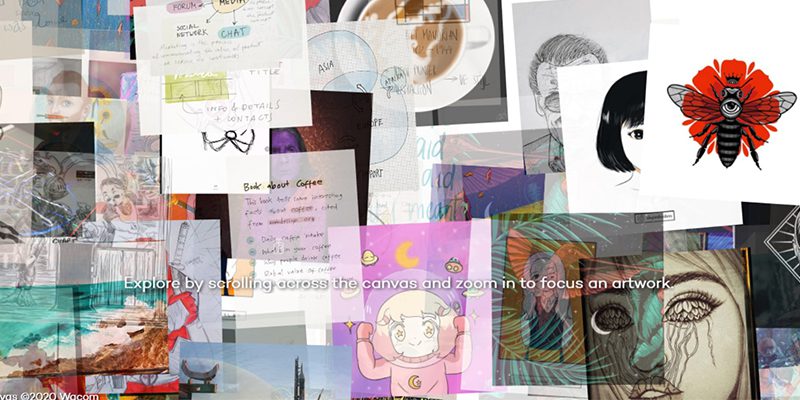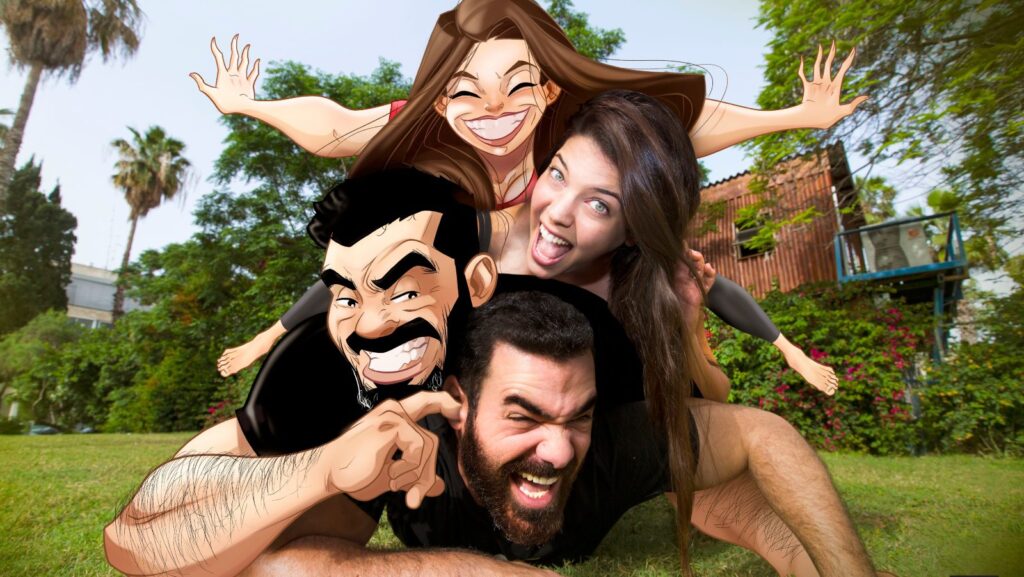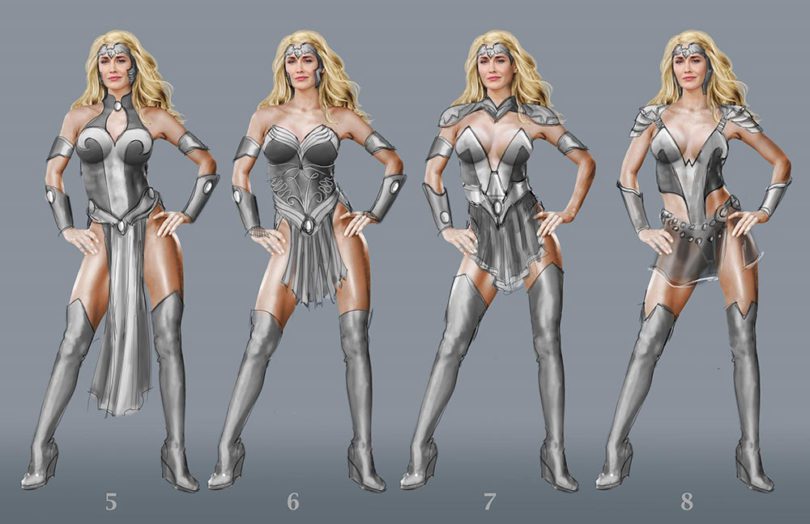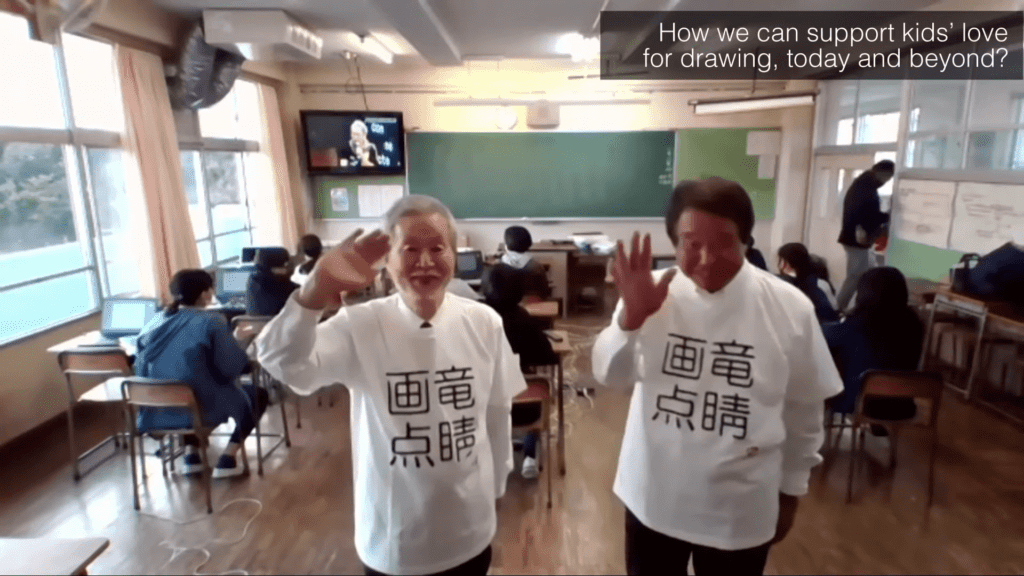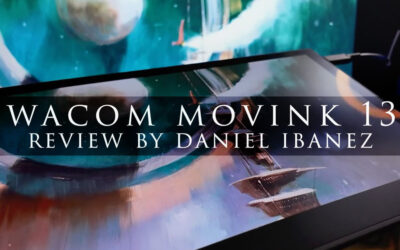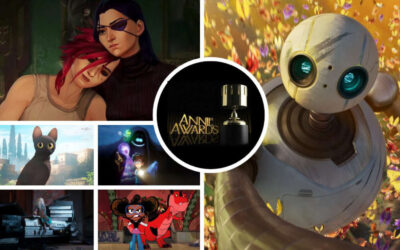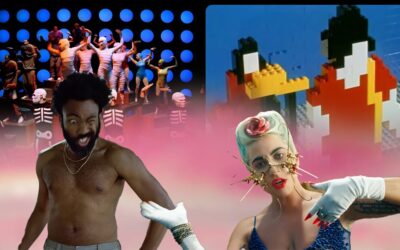Header from Connected Ink’s online art gallery. (It’s just a static image, you can’t scroll on it.)
Our promotional materials bill Connected Ink as an “Open Innovation Platform.” While accurate, I’d say that’s underselling it. It’s more of a multimedia convention: panels and lectures and promos, all focused around digital art and technology, with an art gallery to go with it. A Digital Art Basel, if you will.
Much like Lightbox 2020, it took the form of a series of both pre-recorded videos and live events streaming across a few platforms. It lasts an uninterrupted 24 hours: This year’s was from December 17th at 8 PM JST—or 6 AM EST, where I am—to the same time December 18th. And as you might have guessed from the title, I made it through eighteen. (10 AM to 4 AM.)
It could be divided into two halves, western and Japanese. The western half, which was the first I caught, was a collaborative effort between Wacom America and Europe, conducted from the participants’ homes and through prerecorded videos, via Youtube, Vimeo, and Zoom. The Japanese half was streamed live from a convention center In Shinjuku, Tokyo.
One feature I really appreciated was the countdown clocks to every event. Although I kept a JST to EST converter open in another tab, I often forgot the JST time when I minimized it, so that feature was a lifesaver In fact, I hope every virtual con gets something like that. Physical cons could use them too, (although I understand they’re hard to print on paper).
Like any convention, it was hard to catch all of every panel I wanted to see, and I missed parts of things. But all of them except the first one are now on Wacom’s two Youtube channels. Here’s the playlist for the first (Wacom America/Japan’s) half.
…But I’m guessing you’ll want to know why you should watch them, not just where. So here are the notes I took during the event. Read on!
Highlights
Part 1
12 PM (2 AM JST) — One of Those Days
The Devirs with their comic counterparts
If you follow webcomics or are active enough on social media, you’ve probably seen Israeli couple Yehuda and Maya Devir’s One of Those Days somewhere. Their usually-wordless one-panel comics—a format they say they settled on to speak to a worldwide audience—aren’t just the #relatable gags they might seem at first glance, but a journal of their entire course through cohabiting, marriage, having a kid, and starting a career.
In this energetic panel, they go into detail on that course and how the comic helped them through it, taking Yehuda from a struggling illustrator (I particularly enjoyed his complaints about people wanting him to work for exposure) to making a comfortable living due to the exposure he generated himself with the comic. This is the first panel to really reach out and grab me. Their passion for their work, the relationship that inspired it, and their fans, are obvious and infectious. Honorable mention to Maya for being the most excited storyteller I’ve ever seen on a livestream.
I can’t find a video of this one, which is unfortunate for your first impression, but all the other ones have them. Here’s their TED talk from last year if you want to see them in action, though, as well as their Youtube channel, which they update with impressive regularity.
1 PM (3 AM JST) — Creativity in Action
This one is a costumed life-drawing session brought to us by Wacom’s partners at Drink and Draw Berlin (although in perfect English) and hosted, interestingly enough, on a houseboat.
For anyone who’s never been to one, Drink & Draws are a worldwide phenomenon, and are exactly what they sound like: People get together to drink while they draw. I’ve been to many, but never seen one livestreamed before, so I didn’t know what to expect. But this was an excellent one.
It takes a format that I’m surprised I haven’t seen from an art stream before: One artist draws from a model, then sits down with the host for an interview while the next artist works, sharing art advice and talking about life. For example, one of my favorite tips is from Annabelle Kraus: Focus a lot of effort on the early stages of a drawing, because “If you base your drawing on a five minute sketch, you can render it out as much as you want, but it’ll still look like a 5-minute sketch.”
Finally, I wanted to congratulate them on the video quality: they mentioned it took them seven hours to set up the livestream, and it shows. The lighting and production were on the level of a TV show. And although prerecorded, it had all the spontaneity and fun of a live show, and was still interactive to a degree—the host participated in the chat bar, answering audience questions via messages.
2:30 PM (4:30 AM JST) — Cartoon Crunch
Backstory: Wacom hosted its first reality show this year. An online one, of course, filmed by the participants themselves, but still a massive undertaking that provided an excellent view into the animation process. As an aside, my favorite part was the technical behind-the-scenes: the work-in-progress frames, the breakdowns of all the backgrounds, the character turnarounds.
Hosted by show creator Mike Morris and Wacom’s own Don Varga, Cartoon Crunch separated eight animation students into two teams, then challenged them to produce a 45-second short, from rough concept all the way to final product… in one week.
“I’ve never had to do this much work in such a small amount of time,” says participant Kasey Uhter, who’d never even used Toon Boom before this.
“It feels like we’ve been here for months,” teammate Brittany Consuegra adds.
But brutal as the deadline was, Crunch pleasantly departed from the reality show formula in that it was a collaborative activity with the only race being against the clock, not a competitive one that encouraged drama. “Pitting people against each other was never supposed to be a part of Cartoon Crunch,” says Morris. “It’s about teamwork,” agrees Varga.
It was spread out over five episodes, and this was the wrapup: Through clips, the panel takes us from how they workshopped their ideas and the feedback that was given to them, through to the animation process, culminating in the reveal of the finished shorts: Witchy Business and A Knight’s Tail.
As someone who’d caught some of Cartoon Crunch but wasn’t able to follow all of it, I feel like I’m getting a great overview of the show, and the sheer amount of work that went into it, through this.
5:15 PM (7:15 AM JST) — Creating Cross-Platform Entertainment
This nicely compact eleven-minute video goes into the making of Gods of Mars, the first movie to use live actors against photorealistic CG backgrounds made with Unreal Engine. For those of you not familiar with Unreal… That’s super not what it’s meant for, which makes it even more impressive that they pulled it off. Unreal is an all-in-one games engine, used to make interactive environments and then have characters move through them. Animations made in it tend to be more along the lines of cutscenes—there’s an impressive community of people who make realistic shorts with it, which can be found on Youtube, and it’s commonly used for architectural visualization, but it never would’ve occurred to me that someone would make a full movie using it with live actors.
And unlike most Unreal projects, the SFX weren’t done with only digital assets. Creators Fonco Studios revived the tradition of kitbashing—taking parts from different kit models, combining them with parts from others, and repainting them to create original vehicles and props—a special-effects trick that goes all the way back to the beginning of sci-fi movies. They then scanned the miniatures into Unreal, animated them, and composited them with live-shot footage. The most exciting part, as they point out, is how these methods can make pro quality even more accessible to low-budget filmmakers. “If you have a computer, you have an Nvidia graphics card, and Unreal, you can make Lawrence of Arabia in your dorm room.”
Finally, the crew talk about editing film with Wacom Tablets and DaVinci Resolve, a similar process to the one Filmmaking Today laid out in my last article. “If I had to do everything in Photoshop on a mouse, it would be like digging a hole with a fork,” says editor Robert Dias.
6:30 PM (8:30 AM JST) — Collaborative, Connected, & Paperless Learning
I’ll have another article on this out later this week.
This panel’s about online learning, aimed at teachers instead of artists. But despite the subject being outside my typical scope, presenter Stacy Roshan makes it interesting.
Roshan is a high school math teacher and EdTech writer. She’s always enjoyed online learning, saying it fits her deliberate and methodical style, and now she specializes in teaching teachers how to use it. She’s been very busy with this during quarantine.
Like Maya Devir, she’s a dynamic speaker whose passion for her subjects shines through, and she walks through the use of Flipgrid, Peardeck, and Kami in much more detail than I could through that article. So if you decide to read it, make sure to follow it up with this.
7:30 PM (9:30 AM JST) — When Hollywood Went from Analog to Digital
This is my favorite panel to this point: Wacom’s Melissa Ashcraft interviews costume design artist Gina DeDomenico-Flanagan about her recent work with the Amazon Prime show The Boys.
DeDomenico’s a pretty big deal in costuming: She’s been at it since the early nineties, and her credits include Escape from L.A., Amistad, The Nutty Professor, The Book of Eli, Looper, 2014’s Godzilla, Lovecraft Country, and the best-picture-nominated The Help. Other projects she’s working on right now include Marvel shows and Star Trek Picard. But due to the panel’s focal show, this panel ends up revolving around the specific intricacies of superhero costumes.
She walks us through how she modernized her process as well. She used to work entirely in traditional media on paper until fairly recently—the last project she did with paint was in 2015, for Tarantino’s The Hateful Eight—but the moment she switched to digital, she realized both the amount of time it would save her and the potential for bonus creativity it unlocked. Costume work is a process of, as Ashcraft puts it, “A whole lot of drawing and a whole lot of revising,” creating variants, discarding variants, and redrawing parts until you get something the director likes.
“I can change a green costume to a blue costume in two seconds. In the old days, if the designer wanted to see a different color, it would take me at least a day to redraw the whole thing,” she says. Now, she can also add textures and design multiple variants of a costume over the same maquette, letting her offer directors many more options.
But even the insights into how the industry worked back in the days when everything had to be done in person were still fascinating: Working in the studio’s office, at the desk right next to the production designer; or on work-from-home days, going to FedEx office to scan paintings so she could email them, spending hours tweaking them over and over to get rid of the scanners’ color distortion…
After Hateful Eight, she flew by the seat of her pants on digital projects, working at the top of her game, but picking up just enough Photoshop to do what was required for each job. “I made it through because I had to,” she says. So let that be a lesson to aspiring industry creatives who think they’ll need absolute technical mastery of a program to get a job. Being willing to learn, and to demonstrate proficiency in multiple ones, is what ultimately landed her work. “Take the time to learn Photoshop, Learn zBrush, learn all these programs,” she urges. “If you know them, you will work. So if you have any downtime, learn.”
8:30 PM (10:30 AM JST) — Finding Your Voice and Telling Your Stories
I wasn’t sure what this panel, the final one from Wacom America, would be either, but I soon see why they saved it for last.
Jorge Gutierrez is an accomplished multimedia artist, most known for being a world-class animator who’s been in the game for twenty years—during which it sounds like he’s experienced enough for three lifetimes.
He’s also an astounding storyteller. Despite getting distracted from other panels (nothing personal, just a necessity if you’re going to play audio over speakers for 18 hours while still having household tasks to do), every time my attention strayed from this one, he reached out and seized it back.
Born in Mexico City and raised in Tijuana just blocks from the border, he was the child of two artists and inherited their ways. Although he lacked the privilege that allowed many future famous artists to get a head start in their craft, his resourcefulness and his passion for Mexican culture formed the foundation of a successful career. He summarizes his philosophy as, “I’m going to go into my past and go into myself—a lot of these memories are painful, but I’ll let them be the dirt where I can plant these stories.”
Where he truly hooks me is the magical story of how he got into CalArts by accident: After having the drawings he did of American cartoon characters—what he thought would get him a job—shot down hard, he accidentally left his painting portfolio, containing his personal works, out on the table. “You will not draw the things you think people want to see!” said the portfolio reviewer, the venerable Jules Engel, almost 90 at the time. “You will draw the things that come out of you—that you feel!”
He struggled mightily through the next decade, working all sorts of jobs at studios around Hollywood, being hired and fired, and even having his pitches dismissed on the basis of race. (The early aughts were an awful time.) But he always made lemonade somehow. Especially amazing is his story of being laid off after 9/11 when Sony shut its entire animation division, then immediately starting his own studio by taking some of the computers and scanners they abandoned and wheeling them out in shopping carts.
But the funniest one by a mile was his disastrous, unprepared pitch to Guillermo del Toro to produce The Book of Life, where he left his concept art in the car and handed in a script he’d spilled tequila on. Del Toro dismissed it as the “worst pitch he’d ever seen.” …Only to reveal he was a longtime fan of Gutierrez’s TV series El Tigre and enthusiastically accept.
He wraps up by talking about his Mexican street art parodies of pop culture figures, then discussing (to the limited extent he’s allowed) his upcoming fantasy epic for Netflix, Maya and the Three.
A Q&A session with Wacom’s Elizabeth Garcia brings about his final and most inspiring story: his dad’s speech about being your best self, which he called a “super-macho.” (And it isn’t what you’re probably thinking. Find out yourself.)
Some of these panels can be summarized well enough in text, but if you only choose one to actually watch, let it be this.
Seriously, watch this one.
Part 2
It’s night in the US now, so this is where the English portion of the stream ends. In the words of Ghostface, “It’s Japan’s turn now, the Earth has spun around.”
Here’s the channel for Japan’s half, containing all the videos below and many more.
11 PM (1 PM JST) — Why Connected Ink?
Kicking off this portion of the night is an address by Nobutaka Ide, the CEO of Wacom Japan, a figure who I’ll admit I’m unfamiliar with. In sweatpants, a black tee, and (a detail I won’t notice until a future panel) two scarves, he doesn’t look very much like a CEO, but exactly like the CEO of an arts and tech company. His speech is soundtracked live by a piano player who—as the translator puts it, “[plays] the keys in this keynote,” a pun I assume also works in Japanese.
Ide runs us through the history of Connected Ink, from its humble beginnings in Las Vegas (not where I would’ve thought) where just twenty people attended and there was no online audience, to today, where it takes up a Tokyo convention center and is a multiplatform streaming event.
Connected Ink’s mission has changed, he says. Although it started out as a mere corporate event, “The event is moving toward a more fundamental thing for human beings,” adds CELSYS’s CEO in a video clip.
The company’s objective as a whole has changed as well, he says. When he started, he was thinking about little more than just moving units—but now, Wacom’s mission has become what he sums up with the phrase “Dogu-ya,” roughly meaning “Tool-seller.” Looking it up, dogu is a term that doesn’t quite translate to one English word, meaning “instruments of the way.” Maybe a translation of the meaning in context would be “channeling device,” since as Ide continues, this new Wacom’s goal is to create a whole medium for art to flow through, not just plastic peripherals. “We support the experience of writing and drawing: That is our mission.”
This is a theme that will run through the entire Japanese half: The most striking difference between the two is that where Wacom America’s presentations are focused on use cases for tablets, Wacom Japan’s are focused on big spiritual visions and philosophies.
Ide describes the company’s growth with liquid metaphors—at one point, a wave washing over everyone involved in it; at another point, a self-perpetuating whirlpool, drawing us all into what he calls “creative chaos,” powered by the participants’ kotodama—a term later defined as “a vibrational energy implemented with someone’s soul.”
“I hope we can all embrace creative chaos together,” he concludes.
Honorable Mentions
11:30 PM (1:30 PM JST) —Live Experience Zone II
Next up, a demonstration of the mui.
The what? Glad you asked. I admittedly had trouble following this portion due to a volume conflict between the host’s microphone and the translator’s, so it took some digging into to find out, myself.
From their website
The mui (Japanese for “silence,” spelled in lowercase) is a smart hub built into a wooden board. It has an embedded touchscreen with a minimal interface of white LED lights that show through the wood’s surface. It integrates with Google Assistant and various devices, can control smart appliances, tell you the weather, and remind you of events just like any other smart hub; and has voice recognition, although true to its name, it answers in writing. Created by a Kyoto startup of the same name, it’s designed to be unobtrusive, fit in with minimalist design styles, and promote a calm atmosphere. It won’t give you eye strain when you’re using it, and won’t make any noises to distract you when you’re not.
Apparently, it also integrates Wacom Technology: In this demonstration, inventor Nobuyasu Hirobe shows how you can write on it with a stylus, and it’ll digitize your handwriting and post the message online.
Behind the table where the mui’s being displayed, he’s also worked with the design team KOPPA (who constructs all Wacom’s expo furniture) to build a mysterious arch. It’s shaped like a very simple house, but with a walkway through it, and there are multiple muis attached to it, as well as two LED screens. He calls it the Information Gateway.
Tapping one of the muis displays a message—it’s not translated, but from what I gleaned, it appears to be a comment from a Japanese Connected Ink viewer. “The emotions and the feelings of our online audience are to be collected into this hut,” Hirobe explains.
1:30 AM (3:30 PM JST) How can we support kids’ love for drawing, today and beyond?
For this panel, Ide is joined by the president of CELSYS, makers of Clip Studio Paint, and the school superintendent of Ōiso, Kanagawa.
This one also took a little after-the-fact research to piece together the full story, (although the audio was fine): Ōiso is a distant exurb of the Tokyo-Yokohama metro, a small seaside town an hour and a half away from the convention. We embarked on a project to give a Wacom One and a copy of CELSYS’s new “Clip Studio Junior*” to every kid in the town high school, gauging the effects on the students’ motivation and creativity. Apparently they loved it. “We have state of the art hardware and software, and children are quite positively shocked,” says the superintendent.
*I think this might be another name for Clip Studio Paint DEBUT.
Charmingly, they’re joined via videochat by the mayor of Ōiso and the principal of the school, standing in front of a class full of students whose faces are buried in their Ones. I can not talk to them because they’re so concentrated they would not respond to me!” says the mayor.
CELSYS’s CEO explains his motivation for participating: To give the kids the same opportunity he had to discover art that led him to his current position. “I was not good at school, I was not fast at running, but I was good at drawing. Drawing and painting helped me get through my school years, and art made my life richer,” he says. “If I had not met art, I do not think I would have been here.”
—
This is the last panel I fully wrote up before tapping out a couple hours later, but much more of Wacom Japan’s content can be seen on the playlist above. (Or, here, I’ll link it again.) There are music and dance performances, panels on anime and manga, panels on the everyday use of tablets, and even more, that I wasn’t able to include.
—
Impressions
Despite my working for Wacom, I feel my advice and recommendations aren’t worth anything unless backed up by a certain amount of honesty. So in the interest of that, I’ll say that Connected Ink isn’t a perfect event, and the main area in which it could improve is accessibility. This is largely due to it being two cons on one—and in some ways, four.
Connected Ink is half art show, half trade show, and it might help to see more separation between the two.
Due to the reader demographics of this blog (mostly artists), some of the other panels I watched but didn’t write up were focused on super-specialized use cases: Like the one by professional handwriting analyst Niko Kalantzis on how to identify forgeries, or ones on digital rights management and medical record filing. Some of these were more interesting than they seemed (especially Kalantzis’s) but they were meant for a very specific niche audience that could benefit from their own space and targeted promotions, so they know where to find it.
The con was already divided into three “stages,” one main stage for the headlining events and two side stages with multiple panels running at once: maybe one side stage could be exclusively for arts and entertainment panels and the other could be for technical and business-oriented panels, with different marketing efforts for each audience.
But: What Connected Ink is, is a collection of gems in the rough. As the panels I highlighted prove, it’s much more than a mere corporate event. I empathize with Ide’s vision and understand exactly what he’s trying to do with the event: And if it stays on its current trajectory, it could grow into a major convention for both artists and people who use graphics devices for other, more unorthodox, purposes.
It might be imperfect, but it’s very worthwhile, and judging by how far it’s come since that Las Vegas hotel, I think it’ll only get better every year.
—
About the Author
CS Jones is a Greater-Philadelphia-based writer and illustrator, currently writing and illustrating a debut novel in between articles. You can see all of his work, including most of his contributions to this blog, at thecsjones.com, or follow him at @thecsjones on Instagram or Twitter.

